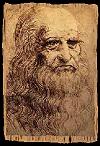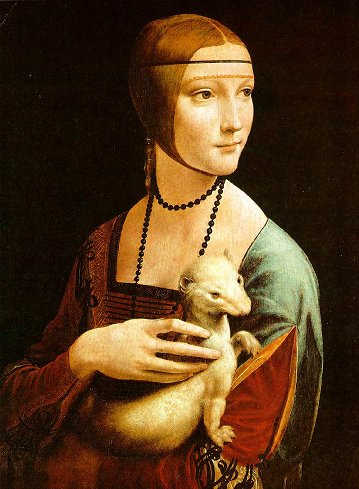|
The painting, Lady With The Ermine, is thought to date from Leonardo's early years in Milan (c. 1482-1483). Like all of his portraits (with the exception of the Mona Lisa), there is some disagreement about this painting. Some historians consider that the sitter is Cecilia Gallerani, mistress of Ludovico Sforza (the Duke of Milan). Renaissance women contrived to look middle-aged before they were twenty and if it is her she would only have been about seventeen at the time. Another suggestion is that the painting is from a little later, around 1491, and that the woman is Ludovico's wife, Beatrice d'Este.
The third theory is that the subject may have been La Belle Ferronniere, a nickname given to the mistress of Francis I of France. Though some support for this idea came from an inscription in the upper left-hand corner which reads LA BELE FERONIERE LEONARD DA WINCI, most experts now consider this to be incorrect. The inscription is not original, but is a later addition. Speculation also exists over whether this painting is partially or entirely by Leonardo, or possibly by Ambrogio da Predis or Boltraffio. Lady with The Ermine has been heavily over painted. The entire background was darkened, her dress below the ermine was retouched and a transparent veil being worn by the woman was repainted to match the colour of her hair. The result of this last retouching has been to give the appearance that her hair reaches down and underneath her chin. Yet another change was the addition of dark shadows between the fingers of her right hand, a close look at the bottom two fingers shows they are quite inferior to the others after an unknown restorer repainted them. An x-ray of this painting revealed the presence of a door in the original background. There are a number of things to support the idea this is Cecilia Gallerani, and that it was painted by Leonardo himself. Firstly, the ermine was used as a heraldic figure by Ludovico, it appeared on his coat of arms. Secondly, despite the heavy retouching of the painting the woman's face and the animal are intact, and the colours used were those Leonardo favoured during his first years in Milan. Despite her young age at the time of this portrait, Cecilia had already been seduced by Lodovico, had borne him a son and held a very commanding position at court.
The strongest pointer of all is a request made in 1498 from Isabella d'Este. She asked for the portrait on loan as she wished to see a sample of Leonardo's work. Cecilia replied on the 29th April saying she would have sent it with even greater pleasure if it had been more like her. She begged the Marchioness not to think this was the fault of 'the master', explaining it was done when she was very young and since that time she had changed so much no one would recognise it as being her. This also helps to date the picture. To help further in the dating we have a sonnet by the Court poet, which was written about the portrait. In this, he said that she 'seemed to listen and not to speak'. A study of the apparent mood of the subject shows this to be an apt description. Poet, Bernardo Bellincioni, died in 1492 so the portrait must be prior to that date. Leonardo composed his paintings using geometric proportions, and mathematical principles discovered by the ancient Greeks; this was typical of Renaissance painters. In this painting the pyramid is the invisible base upon which he built. Particularly interesting about the design of this painting is the lack of straight lines. It is composed almost entirely of curves which carry the eye from the woman's head, down to the right, across the ermine and then back up the other sleeve. The only almost straight lines to be seen are the band on her head and the square-cut neckline on her dress. The delicate little animal has been identified as an ermine in its winter coat; according to legend these animals died if their white coats became dirty. These animals were considered to be a symbol of chastity from as early as the third century after Christ; its use here is somewhat ironic considering that in this period a woman was required to be chaste, but also a most devoted mistress. The presence of the ermine also injects a subtle touch of humour to the portrait since its Greek name of galee offered a pun on her own name. Leonardo reproduced an amazingly wide variety of animals in his work and said of the ermine that it "does not eat other than once a day, and it will rather be taken by hunters than escape into a dirty lair." In Leonardo's time apprentices would make soft-hair brushes with bunches of fur from the tail tips of ermine or stoats. Brushes were made by fitting the fur to a small piece of quill; this, in turn, had a wooden handle attached to it. Harder brushes were made of white pig's bristles. Prior to use on a fine painting these would be softened by use whitewashing walls. The ermine is related to the Russian sable, an animal whose fur is used for the manufacture of very high-quality modern brushes. |
|


